Mercedes-Benz W116
The Mercedes-Benz W116 is a series of flagship luxury sedans produced from September 1972[2] until 1980.[3] The W116 automobiles were the first Mercedes-Benz models to be officially called S-Class, although earlier sedan models had already unofficially been designated with the letter 'S' – for Sonderklasse or "special class." The W116 was selected European Car of the Year in 1974.
| Mercedes-Benz W116 | |
|---|---|
_sedan_(2015-07-09)_01.jpg.webp) | |
| Overview | |
| Manufacturer | Daimler-Benz |
| Production | 1972–1980 |
| Assembly |
|
| Designer | Friedrich Geiger (1969)[1] |
| Body and chassis | |
| Class | Full-size luxury car (F) |
| Body style | 4-door sedan |
| Layout | FR layout |
| Related | Mercedes-Benz R107 Mercedes-Benz W123 |
| Powertrain | |
| Engine | 2.8L M110 I6 3.5L M116 V8 4.5L M117 V8 6.9L M100 V8 3.0L OM617 I5 turbodiesel |
| Transmission | 3-speed 722.0 automatic 4-speed 722.1 automatic 4-speed manual 5-speed manual |
| Dimensions | |
| Wheelbase | 2,865 mm (112.8 in) 2,965 mm (116.7 in) (SEL) |
| Length | 4,960 mm (195.3 in) 5,060 mm (199.2 in) (SEL) 5,220 mm (205.5 in) (SE US bumpers) 5,334 mm (210.0 in) (SEL US bumpers) |
| Width | 1,870 mm (73.6 in) |
| Height | 1,410 mm (55.5 in) & 1,430 mm (56.3 in) |
| Chronology | |
| Predecessor | Mercedes-Benz W108 |
| Successor | Mercedes-Benz W126 |
History
The 'new' S-class generation development began in 1966, which was only a year after the launch of the W108/09. This was the first Mercedes saloon to feature the brand new corporate styling theme which was to be continued until 1993 when the 190 was discontinued. The design, finalized in December 1969[4] was a dramatic leap forward, with more masculine lines that combined to create an elegant and sporty character. The basic design concept carried through the themes originally introduced on the R107 SL-Class roadster, especially the front and rear lights.[1] As for the SL, the W116 received the ridged lamp covers which kept dirt accumulation at bay; this was to remain a Mercedes-Benz design theme into the 21st century.[5] The W116 was Friedrich Geiger's last design for Mercedes-Benz; his career had started with the Mercedes-Benz 500K in 1933.
The car was presented in September 1972. The model range initially included two versions of the M110 engine (Straight-six with 2746 cc displacement)—the 280 S (using a Solex carburetor) and the 280 SE (using Bosch D-Jetronic injection), plus the 350 SE, powered by the M116 engine (V8 with 3499 cc displacement). After the 1973 Fuel Crisis, a long-wheelbase version of the 280 was added to the lineup.
Half a year later, in early 1973, two new models powered by the M117 engine (V8 with 4520 cc displacement) were added to the range—the 450 SE and the 450 SEL (with a 100 mm longer body). The 450 had 225 PS (165 kW) in most markets, federalized cars offered 190 hp (142 kW) while Swedish market cars had an EGR-valve and 200 PS (147 kW) until 1976.[5] The 450s received a plusher interior as well, with velour or leather seats rather than the checkered cloth of the lesser models. The door insides were also of a different design, being pulled up around the windows.[6]
The most notable W116 was the high-performance, limited-production 450 SEL 6.9, which was introduced in 1975. This model boasted by far the largest engine installed in a post-war Mercedes-Benz (and any non-American production automobile) up to that time,[7] and also featured self-leveling hydropneumatic suspension.
The 300 SD sedan (American market only) had a turbocharged 3.0-litre inline-five diesel engine developed from the C111 experimental vehicle.
The 450 SE was named the European Car of the Year in 1974, even though the W116 range was first introduced at the Paris Motor Show in the fall of 1972.[8] The W116 range became the first production car to use an electronic four-wheel multi-channel anti-lock braking system (ABS) from Bosch as an option from 1978 on.
Production totaled 473,035 units. The W116 was succeeded by the W126 S-Class in 1979. The W116 was sold throughout Europe, the Americas, Asia, the Middle East, Africa, and Australia.
Models
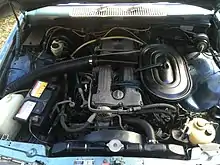
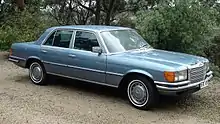
In 1975, the W116 was upgraded with a new fuel injection system to comply with revised exhaust emission standards in European markets. A slight power reduction was a result of this update. In 1978, a series of engine upgrades restored original performance levels with new fuel injection systems. Initially the early models (1973-1974) of the W116 with the Twin Cam inline 6 used the D-Jetronic fuels injection system with computers and MAP sensor that are both prone to failure after more than 20 years of use. From 1975 onward they used the K-Jetronic mechanical fuel injection system, a less complicated system that proved to be much more reliable in the long run and injectors cost 6x less than the D-jetronic system. The W116 equipped with the K-Jetronic system, used a cast-iron fuel distributor, which can be prone to rust over time if moisture or water is present in the fuel. This was changed to an alloy fuel distributor in the following model W126 and is not subject to corrosion.
| Chassis code | Model Years | Model | Engine | No. built[9] |
|---|---|---|---|---|
| W116.020 | 1973–1980 | 280 S sedan | 2.8 L M110 I6 | 122,848 |
| W116.024 | 1973–1980 | 280 SE sedan | 2.8 L M110 I6 | 150,593 |
| W116.025 | 1974–1980 | 280 SEL sedan | 2.8 L M110 I6 | 7,032 |
| W116.028 | 1973–1980 | 350 SE sedan | 3.5 L M116 V8 | 51,100 |
| W116.029 | 1973–1980 | 350 SEL sedan | 3.5 L M116 V8 | 4,266 |
| W116.032 | 1973–1980 | 450 SE sedan | 4.5 L M117 V8 | 41,604 |
| W116.033 | 1973–1980 | 450 SEL sedan | 4.5 L M117 V8 | 59,578 |
| W116.036 | 1975–1980 | 450 SEL 6.9 | 6.9 L M100 V8 | 7,380 |
| W116.120 | 1978–1980 | 300 SD sedan | 3.0 L OM617 I5 turbodiesel (United States and Canada only) | 28,634 |
450 SEL 6.9
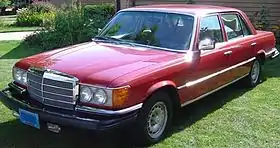
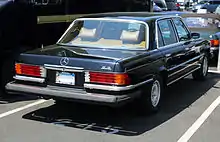
The high-performance 450 SEL 6.9 version of the S-Class was built on its own assembly line by Daimler-Benz in Stuttgart, Germany and based on the long-wheelbase version of the W116 chassis. The model was generally referred to in the company's literature as the "6.9", to separate it from the regular 450 SEL.
The 6.9 was first shown to the motoring press at the Geneva Auto Show in 1974, and produced between 1975 and 1981 in extremely limited numbers. It was billed as the flagship of the Mercedes-Benz car line, and the successor to Mercedes-Benz's original high-performance sedan, the 300 SEL 6.3. The 6.9's successor—the top of range 500 SEL—continued the 6.9's remarkable self-leveling hydropneumatic suspension as an extra-cost option.
Special features
The 6.9 was the first Mercedes-Benz to be fitted with the hydropneumatic self-levelling suspension system introduced by Citroën in 1954, unlike the 600 and 6.3 which employed air suspensions. Using a combination of fluid-filled struts and nitrogen-filled pressure vessels or "accumulators" in lieu of conventional shock absorbers and springs, the system was pressurized by a hydraulic pump driven by the engine's timing chain. Compared to the new Mercedes-Benz system, Citroën's was belt-driven, exactly like a conventional power steering pump; failure of the Citroën system thus might result in loss of suspension. Conversely, every unit of the 6.9 was shipped with hard rubber emergency dampers that served as temporary springs and allowed the car to be driven in the event of a hydraulic failure. The special hydraulic fluid required by the system was stored in a tank inside the engine compartment. Not only was the system totally self-adjusting, ride height could be altered by a dash-mounted push-pull knob under the speedometer that raised the car an additional two inches (50 mm) for increased ground clearance.
The suspension system gave the 4,200 lb (1,905 kg) car the benefits of a both a smooth ride and handling that allowed it, in the words of automotive journalist David E. Davis, to be "tossed about like a Mini." The car also featured a model W3B 050 three-speed automatic transmission unique to the 6.9 and a standard ZF limited slip differential both for enhanced roadholding performance on dry pavement and enhanced traction in inclement weather.
Four-wheel disc brakes and four-wheel independent suspension were standard on these top-of-the-line models. The M100 engine is a cast iron V8 with single overhead camshafts which was a bigger version of the engine also used in the Mercedes-Benz 600 and the Mercedes-Benz 300SEL 6.3. Notable is the Bosch K-Jetronic electromechanical fuel injection, forged crankshaft, connecting rods and pistons, and a "dry sump" engine lubrication system. As a result, the engine itself had no dipstick for checking the oil level. Rather, the dipstick was attached to the inside of the tank's filler cap (accessible from the engine compartment) and the oil level was checked with the engine running and at operating temperature. The non-American market trim version of the 6.9 l (6,834 cc or 417 in³) power plant was rated at 286 PS (210 kW; 282 hp) and 405 lb·ft (549 N·m) of torque, helping to compensate for the 2.65 to 1 final drive ratio necessary for sustained high-speed cruising. The dry sump system also had the benefit of extending the oil change interval to 12,500 miles (20,000 km). This, along with hydraulic valve lifters which required no adjusting and special cylinder head gaskets which eliminated the need for periodic retorquing of the head bolts, made the 6.9 relatively easy to maintain and service for its first 50,000 miles (80,500 km). The 6.9 required little basic service other than coolant, minor tune-ups, oil changes, and replacement of the air, fuel, oil and power steering filters.
Performance
Top speed was factory-rated at 140 mph (225 km/h), but some journalists testing the car saw speeds approaching 150 mph (241 km/h). Among those journalists was Brock Yates. Yates was approached by the factory to write promotional literature about the 6.9 for advertising purposes. He agreed under the condition that he could list the car's faults as well as its positives and create an unbiased review. Daimler-Benz agreed and Yates was given an American-market spec 6.9 to drive from Manhattan to the Road Atlanta grand prix race track in Georgia. There, Yates would drive the car in as-arrived condition at racing speeds for a full 40 laps or just over 100 miles (160 km). His complaint on this long drive on public roads was that the magnetic CB antenna blew off at 130 miles per hour. The only change made to the car upon its arrival at Road Atlanta was an adjustment of tire pressure. Driving 40 laps was a difficult task for the street-legal full size luxury sedan primarily designed and geared for comfortable Autobahn cruising. The 6.9 suffered no major mechanical problems and averaged a respectable 72 mph (116 km/h) throughout the test, completing it with little more than excess dust on the bodywork from the Michelin radial street tires on which the car was driven to Atlanta. Yates was so comfortable driving the 6.9 around the track that he reported having run at least one lap with the sunroof open and the radio on, but the high price of the car made him think better of such risky driving and he finished the test with the radio off and both hands on the wheel.[10]
Price and interior features
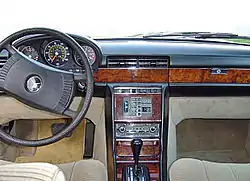
All of this technology came at a very high price. At a time when the most expensive Cadillacs, the mid-sized Seville and full-sized Cadillac Fleetwood Series Seventy-Five limousine each listed for about US$16,000, the 6.9 listed for around $40,000, more than the Big Three but less than most Rolls-Royces. When the car was officially introduced into the North American market for the 1977 model year, the price was well past $40,000 and was $52,995 by the end of production. Though the 6.9 was undeniably a luxury car, the decor was rather austere compared to the sheer opulence available in a Rolls-Royce or full-sized Cadillac. The interior was identical to that in the less expensive models except for the push-pull suspension control knob just under the speedometer, a low suspension pressure warning and height adjustment indicator lights in the instrument cluster, and wood trim finished in burled walnut veneer on the dash and console. The rest of the W116 lineup was trimmed in striated zebrano veneer. US models also had different bumper rubbers fitted to the more protruding "park bench" impact absorbing bumpers.
The 6.9 lacked expected luxury touches such as power-adjustable outside mirrors or front seats, although a unique power rear seat, heated seats and even orthopedically designed front seats were options. Buyers outside North America could also opt for headlight wipers and washers and/or headlights with a special vacuum-operated linkage whose aim could be adjusted at the dash depending on vehicle load. There was also a new standard feature in 1976: most Mercedes-Benz automobiles that year were equipped with a sophisticated electronic climate control system developed for Chrysler Corporation for use in their top models. The system turned on the heater, air conditioner or both, depending on the thermostat's setting and ambient temperature, automatically maintaining whatever temperature the driver selected. The compressor was an American import as well, supplied by the Harrison division of General Motors.
Far more modern than the contemporary Cadillac, which still had a live rear axle, and both faster and larger inside than the either the Rolls-Royce or Cadillac, the 6.9 was indistinguishable from its W116 stablemates save for a modest "6.9" badge on the decklid and wider tires.[11] As discreet as the badge was, it could be deleted/ordered with option 261 omission of the displacement figure on the trunk lid at extra cost for those who wanted to avoid attention either from drivers of other high-performance cars or from law enforcement. In the words of David E. Davis, the 6.9 was "a $50,000 exercise in going fast."
For fans of the discontinued 6.3 or for those that wanted a car that Car and Driver proclaimed to be "the greatest Mercedes-Benz ever built," the price was inconsequential. At its launch in 1975, the 450 SEL 6.9 cost DM 69,930. In the last year of production, and by 1979, the price had risen DM 81,247. Regardless of the price Mercedes-Benz marketing strategies strategists resulted in a total production of 7,380 units by 1980, and most of these were exported to the USA. This volume is quite respectable considering the overall sales trend of powerful luxury cars following the 1973 energy crisis.
Today
In a poll conducted by Britain's Classic & Sports Car magazine and printed in their April 1999 edition, the Mercedes-Benz 6.9 ranked fourth on their list of the "world's greatest saloons."[12] The May 2004 edition of another British publication, Mercedes Enthusiast magazine, ranked the 6.9 number fifteen on their all-time top twenty list of great Mercedes-Benz automobiles. Even with such accolades, a 6.9 is a reasonably priced collectible automobile despite its rarity. The online NADA Used Car Guide lists a top value of US$40,000. At present, the market for cars of this type is somewhat soft, and a prime example can be had for considerably less. As is often the case with older cars that contain exotic engineering and parts unique to that one model, however, running and maintenance costs for a 6.9 can quickly overshadow a low initial purchase price.
LeMons Racing
In September 2013, a 1979 W116 300 SD was campaigned in the 24 Hours of LeMons at Carolina Motorsports Park, where it completed 166 laps at an average speed of 54.8 MPH.[13] It won the highest prize of the event, the Index of Effluency. Other than mild issues relating to brake and tire wear, no mechanical issues were encountered. After numerous modifications to handling, the car was again run in February 2014 at Barber Motorsports park in Birmingham, AL. It placed 44th, but turned 281 laps at an average pace of 59.6 MPH. One of the key advantages of the 300 SD in long-distance racing is its exceptional fuel economy on track, where it burns just 2.5 GPH (Roughly 18MPG). In July 2014 it placed first in class at Sebring. It is still active in the series.[14]
Technical data
Technical data Mercedes-Benz W116 [15] (Manufacturer's figures except where stated)
| Mercedes-Benz | 280 S (W116 V28) |
280 SE (W116 E28) |
350 SE (W116 E35) |
450 SE (W116 E45) |
450 SEL 6.9 (W116 E69) |
300 SD (W116 D30A) |
|---|---|---|---|---|---|---|
| Chassis code: | 116.020 | SE: 116.024 SEL: 116.025 | SE: 116.028 SEL: 116.029 | SE: 116.032 SEL: 116.033 | 116.036 | 116.120 |
| Produced: | 1972–1980 | SE: 1972 – 1980 SEL: 1974 − 1980 | SE: 1972 – 1980 SEL: 1973 − 1980 | 1972–1980 | 1975–1980 | 1977–1980 |
| Engine: | 6-cylinder-inline engine (four-stroke), front-mounted | 90° 8-cylinder-V engine (four-stroke), front-mounted | 5-cylinder-inline engine (four-stroke), front-mounted | |||
| Bore x Stroke: | 86 mm x 78.8 mm | 92 mm x 65.8 mm | 92 mm x 85 mm | 107 mm x 95 mm | 90.9 mm x 92.4 mm | |
| Displacement: | 2746 cc | 3499 cc | 4520 cc | 6834 cc | 3005 cc before 1979 2998 cc after 1979 | |
| Engine code: | M110.922 | D-Jet: M110.983 K-Jet: M110.985 | D-Jet: M116.983 K-Jet: M116.985 | D-Jet: M117.983 K-Jet: M117.986 | M100.985 | OM617.950 |
| Max. Power at rpm: | 160 PS (118 kW; 158 hp) at 5,500 USA: 120 bhp (89 kW; 122 PS) at 4,800 | 185 PS (136 kW; 182 hp) at 6,000 USA: 142 bhp (106 kW; 144 PS) at 5,750 | 200 PS (147 kW; 197 hp) at 5,800 | 225 PS (165 kW; 222 hp) at 5,000 USA: 193 PS (142 kW; 190 hp) at 4,750 | 286 PS (210 kW; 282 hp) at 4,250 250 bhp (186 kW; 253 PS) at 4,000 | 1979: 110 bhp (82 kW; 112 PS) at 4,200 1980: 120 bhp (89 kW; 122 PS) at 4,350 |
| Max. Torque at rpm: | 225 N⋅m (166 lb⋅ft) at 4,000 USA: 143 ft⋅lbf (194 N⋅m) | 238 N⋅m (176 lb⋅ft) at 4,500 USA: 149 ft⋅lbf (202 N⋅m) | 286 N⋅m (211 lb⋅ft) at 4,000 | 377 N⋅m (278 lb⋅ft) at 3,000 USA: 240 ft⋅lbf (325 N⋅m) | 550 N⋅m (406 lb⋅ft) at 3,000 USA: 360 ft⋅lbf (488 N⋅m) | 1979: 168 ft⋅lbf (228 N⋅m) at 2,400 1980: 170 ft⋅lbf (230 N⋅m) at 2,400 |
| Compression Ratio: | 9.0: 1 | 9.0: 1 | 9.5: 1 | 8.8: 1 | 8.8: 1 | 21.5: 1 |
| Fuel feed: | One 2-bbl Solex 4A1 | Bosch D-Jetronic, from July 1975 K-Jetronic | Bosch K-Jetronic | Bosch injection pump Garrett turbine | ||
| Fuel tank capacity: | 96 L (25.4 US gal; 21.1 imp gal) | 82 L (21.7 US gal; 18.0 imp gal) | ||||
| Valvetrain: | DOHC, duplex chain | SOHC, duplex chain | ||||
| Cooling: | Water | |||||
| Gearbox: | 4-speed or 5-speed manual or 4-speed automatic rear wheel drive, standard axle ratio 3.69:1 or 3.92:1 (5-speed) |
4-speed manual or 3-speed automatic rear wheel drive standard axle ratio 3.46:1 |
3-speed automatic rear wheel drive standard axle ratio 3.07:1 | 3-speed automatic rear wheel drive standard axle ratio 2.65:1 | 4-speed automatic rear wheel drive standard axle ratio 3.07:1 | |
| Automatic gearbox: model (type) | W4B 025 (722.1)[16] | W3A 040 (722.0)[16] | W3B 050 (722.0) Worldwide[17] W3A 040 (722.0) USA & Japan[17] | W3B 050 reinf. (722.003)[18] | W4B 025 (722.1) | |
| Electrical system: | 12 volt | |||||
| Front suspension: | Double wishbones, coil and additional rubber springs, stabilising bar 6.9: Double wishbones, hydropneumatic damping, stabilizing torsion bar | |||||
| Rear suspension:: | Diagonal swing axle, trailing arms, coil springs, stabilizing torsion bar 6.9: Diagonal swing axle, hydropneumatic damping, stabilizing torsion bar · 4.5 and 6.9: starting anti-dive suspension | |||||
| Brakes: | Disc brakes (Ø 278 mm front, 279 mm rear), power assisted, from 1979 on request ABS | |||||
| Steering: | Recirculating ball steering, manual or servo-assisted | |||||
| Body structure: | Sheet steel, monocoque (unibody) construction | |||||
| Dry weight: | 1,660 kg (3,660 lb) USA: 3,770 lb (1,710 kg) | 1,665 kg (3,671 lb) SEL: 1,700 kg (3,748 lb) USA: 3,750 lb (1,701 kg) | 1,725 kg (3,803 lb) SEL: 1,760 kg (3,880 lb) | 1,740 kg (3,836 lb) SEL: 1,825 kg (4,023 lb) USA: 3,843 lb (1,743 kg) | 1,985 kg (4,376 lb) USA: 4,285 lb (1,944 kg) | 1,815 kg (4,001 lb) |
| Loaded weight: | 2,130 kg (4,696 lb) | 2,130 kg (4,696 lb) SEL: 2,165 kg (4,773 lb) | 2,195 kg (4,839 lb) SEL: 2,220 kg (4,894 lb) | 2,250 kg (4,960 lb) SEL: 2,285 kg (5,038 lb) | 2,420 kg (5,335 lb) | 2,215 kg (4,883 lb) |
| Track front/ rear: | 1,521 mm (59.9 in) / 1,505 mm (59.3 in) | |||||
| Wheelbase: | S/SE: 2,865 mm (112.8 in) SEL: 2,965 mm (116.7 in) | SE: 2,860 mm (112.6 in) SEL: 2,960 mm (116.5 in) | 2,865 mm (112.8 in) | |||
| Length: | 4,960 mm (195.3 in) 5,060 mm (199.2 in) | |||||
| Width: | 1,870 mm (73.6 in) | |||||
| Height: | 1,410 mm (55.5 in) − 1,430 mm (56.3 in) | |||||
| Tyre/Tire sizes: | 185 HR 14 | 205/70 VR 14 | 215/70 VR 14 | 185 HR 14 | ||
| Acceleration 0–100 km/h (0-62 mph): | 11.5s | 10.5s | 9.5s (10.0s SEL) | 8.5s (8.9s SEL) | 7.4s | 17.0s 16.2s (from 10.1979) |
| Top speed: | 190 km/h (118 mph) | 200 km/h (124 mph) | 205 km/h (127 mph) | 210 km/h (130 mph) | 225 km/h (140 mph) | 165 km/h (103 mph) |
| Fuel Consumption (guideline DIN 70030: determined at 3/4 of top-speed (not more than 110 km/h), plus 10%): | 12.5 litres per 100 kilometres (22.6 mpg‑imp; 18.8 mpg‑US) | 13.0 litres per 100 kilometres (21.7 mpg‑imp; 18.1 mpg‑US) | 14.5 litres per 100 kilometres (19.5 mpg‑imp; 16.2 mpg‑US) | 16.0 litres per 100 kilometres (17.7 mpg‑imp; 14.7 mpg‑US) | 10.6 litres per 100 kilometres (27 mpg‑imp; 22 mpg‑US) | |
Features
.jpg.webp)
_sedan_(2016-01-29)_02.jpg.webp)
The W116 S-Class incorporated a broad variety of Mercedes-Benz safety innovations.
- Four wheel anti-lock brakes were first featured as an option on the 1978 W116 S-Class. This system prevents the wheels from locking while braking. The system improves steering control during hard braking situations, and to shorten brake distances.
- Strengthened body structure. The W116 featured a more stable security passenger cell with a stiffened roof frame structure. High strength roof and door pillars, along with other reinforced zones, provided enhanced vehicle occupant protection.
- Deformation zones (crumple zones) in the front and rear.
- A padded dashboard, deformable switches and controls, and a four-spoke steering wheel with impact absorber and broad impact cushion aimed to reduce occupant injury during collisions.
- The fuel tank was no longer fitted at the rear end, but was now placed above the rear axle for added protection.
- Wraparound turn signals made it easier to communicate with nearby drivers.
References
- "W116 : Mercedes-Benz S-Class – 280S, 280SE, 280SEL, 300SD, 350SE, 350SEL, 450SE, 450SEL & 450SEL 6.9". w116.org.
- Garnier, Peter, ed. (21 September 1972). "News". Autocar: 19.
- Werner Oswald (March 2001). Deitsche Autos 1945 - 1990 ... Mercedes-Benz Typ 280 S bis 450 SEL 6,9 (S-Klasse Baureihe 116) 1972-1980. "Der letzte Wagen der Baureihe 116 lief im September 1980 vom Band, obwohl bereits im Dezamber 1979 die Fertigung des Nachfolgers (Baureihe 126) begonnen hatte."). 4. Motorbuch Verlag, Stuttgart. pp. 80–81. ISBN 3-613-02131-5.
- James Taylor (15 December 2013). Mercedes-Benz S-Class 1972-2013. Crowood. p. 40. ISBN 978-1-84797-596-6.
- Stjerna, Mikael (June 2016). "Årets vinnare" [The year's winner]. Klassiska Bilar (in Swedish). Stockholm, Sweden: Bonnier Tidskrifter AB. 5 (5): 40.
- Stjerna, p. 42
- "In the lap of luxury: The Mercedes S-Class W116 | Classic Driver Magazine". Classicdriver.com. 2013-07-11. Retrieved 2016-07-16.
- Stjerna, p. 39
- Oswald, Werner (2003). Deutsche Autos 1945–1990, Band 4 (in German). Stuttgart: Motorbuch Verlag. pp. 80, 86. ISBN 3-613-02131-5.
- "6.9 Brochure – Brock Yates Story". m-100.cc.
- David E. Davis Jr. (July 1977), Mercedes-Benz 450SEL 6.9 – Archived Road Test, Car and Driver
- "Classic & Sports Car, April 1997 – Best Saloons Ever". m-100.cc. Archived from the original on 2018-01-29. Retrieved 2013-06-06.
- "Classification – details – MYLAPS Sports Timing". mylaps.com.
- "Classification – details – MYLAPS Sports Timing". mylaps.com.
- Oswald, Werner (2001). Deutsche Autos 1945–1990, Band 4. Stuttgart: Motorbuch Verlag. ISBN 3-613-02131-5.
- "MB Passenger Car Series 116, PDF p. 10" (PDF).
- "MB Passenger Car Types with Engine M117, PDF p. 14" (PDF).
- "MB AUS 1979, PDF p. 57" (PDF).
Bibliography
General
- Alder, Trevor (1996). Mercedes-Benz S-Class Saloons, 1972–91: Road Tests & Articles. Transport Source Books. ASIN B005U5LANQ.
- Barrett, Frank (1998). Illustrated Buyer's Guide Mercedes-Benz. Motorbooks International Illustrated Buyer's Guide series (2nd ed.). Osceola, WI, USA: MBI Publishing. ISBN 0760304513.
- Häußermann, Martin (2006). Mercedes-Benz S-Class: The brochures since 1952. Archive edition of the DaimlerChrysler Group Archive. Bielefeld, Germany: Delius Klasing. ISBN 3768817202.
- Hofner, Heribert (1997). Die S-Klasse von Mercedes-Benz: von der Kultur des Fahrens [The S-Class from Mercedes-Benz: from the culture of driving] (in German). Augsburg: Bechtermünz Verlag. ISBN 3-86047-589-4.
- Hofner, Heribert; Schrader, Halwart (2005). Mercedes-Benz Automobile Band 2: von 1964 bis heute [Mercedes-Benz Automobiles Volume 2: from 1964 to today]. Königswinter, Germany: Heel. ISBN 3898804194. (in German)
- Kittler, Eberhard (2000). Typenkompass Mercedes-Benz Band 1. Personenwagen 1945 - 1975 [Typenkompass Mercedes-Benz Volume 1. Passenger Cars 1945 - 1975]. Typenkompass series. Stuttgart: Motorbuch Verlag. ISBN 361302019X. (in German)
- Kittler, Eberhard (2002). Typenkompass Mercedes-Benz Band 2. Personenwagen seit 1976 [Typenkompass Mercedes-Benz Volume 2. Passenger Cars since 1976]. Typenkompass series (in German). Stuttgart: Motorbuch Verlag. ISBN 3613022095.
- Niemann, Harry (2006). Personenwagen von Mercedes-Benz: Automobillegenden und Geschichten seit 1886 [Passenger Cars from Mercedes-Benz: Automobile Legends and Stories since 1886]. Stuttgart: Motorbuch Verlag. ISBN 3613025965. (in German)
- Oswald, Werner (2001). Mercedes-Benz Personenwagen Band 2 1945–1985 [Mercedes-Benz Passenger Cars Volume 2 1945–1985]. Stuttgart: Motorbuch Verlag. ISBN 3613021684. (in German)
- Parish, Julian (2020). Mercedes-Benz S-Class: W116-series 1972 to 1980. Essential Buyer's Guide Veloce series. Dorchester, Dorset, UK: Veloce Publishing. ISBN 9781787115637.
- Röcke, Matthias (1991). Das große Mercedes-S-Klasse-Buch: alle Modellreihen von W 108 bis W 140 (1965 bis heute) [The Big Mercedes S-Class Book: all model codes from W 108 to W 140 (1965 to today)]. Königswinter, Germany: Heel. ISBN 3893652345. (in German)
- Röcke, Matthias (2003). Das neue große Mercedes-S-Klasse-Buch [The New Big Mercedes S-Class Book]. Königswinter, Germany: Heel. ISBN 3898801586. (in German)
- Schlegelmilch, Rainer W.; Lehbrink, Hartmut; von Osterroth, Jochen (2013). Mercedes (revised ed.). Königswinter, Germany: Ullmann Publishing. ISBN 9783848002672.
- Storz, Alexander Franc (2010). Mercedes-Benz S-Klasse: Baureihe W 116. Schrader-Typen-Chronik series (in German). Stuttgart: Motorbuch Verlag. ISBN 9783613031838.
- Taylor, James (1986). Mercedes-Benz since 1945: A Collector's Guide. Volume 3: The 1970s. Croydon, UK: Motor Racing Publications. pp. 6–22, 61–88, 127–129, 133–135, 139–140. ISBN 0900549971.
- Taylor, James (2014). Mercedes-Benz S-Class 1972-2013. Ramsbury, Marlborough, UK: The Crowood Press. ISBN 9781847975959.
Workshop manuals
- Mellon, Thomas A, ed. (2001). Chilton Mercedes: Coupes/Sedans/Wagons, 1974-84 Repair Manual. Chilton Total Car Care Series. Radnor, PA, USA: Chilton; Sparkford, UK: Haynes. ISBN 0801990769.
- Schauwecker, Steve; Haynes, John H. (1987). Mercedes-Benz 350 and 450: 1971 thru 1980 3.5 and 4.5 liter V8: 350 SL, 450 SE, 450 SEL, 450 SL, 450 SLC: series 107 and 116 models with fuel-injected V8 engines and automatic transmissions. Haynes Service and Repair Manual Series. Sparkford, UK: Haynes. ISBN 0856966983.
- Mercedes S-Klasse, Serie 116, ab 1972: 280S/280SE/350SE/450SE/450/SEL. Reparaturanleitung series, Band 1042. (in German). Zug, Switzerland: Verlag Bucheli. 2012. ISBN 9783716817933.
- Mercedes 280 S / 280 SE / 350 SE / 340 SE / 450 SEL bis Aug 79. Reparaturanleitung series, Band 267/268. (in German). Zug, Switzerland: Verlag Bucheli. 2013. ISBN 9783716813317.
- Mercedes-Benz Technical Companion. Cambridge, MA, USA: Bentley Publishers. 2005. ISBN 9780837610337.
External links
| Wikimedia Commons has media related to Mercedes-Benz W116. |
- International M-100 Group — Factory-authorized site with information on all M-100-powered Mercedes-Benz automobiles, (including technical forums and maintenance information). The Brock Yates article can be found here as well
- A Mercedes for the '70s: The W116 Series S-Class — A site mixing the history of the full-scale W116 with that of its many miniature replicas.
- Classic Car driver review
- Golden Brown: Four Days in a Mercedes-Benz 450SEL 6.9 – Feature (Car and Driver)